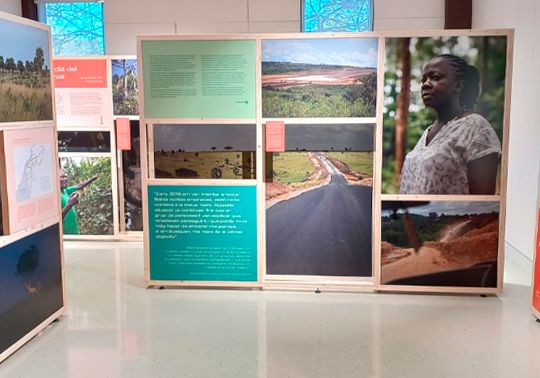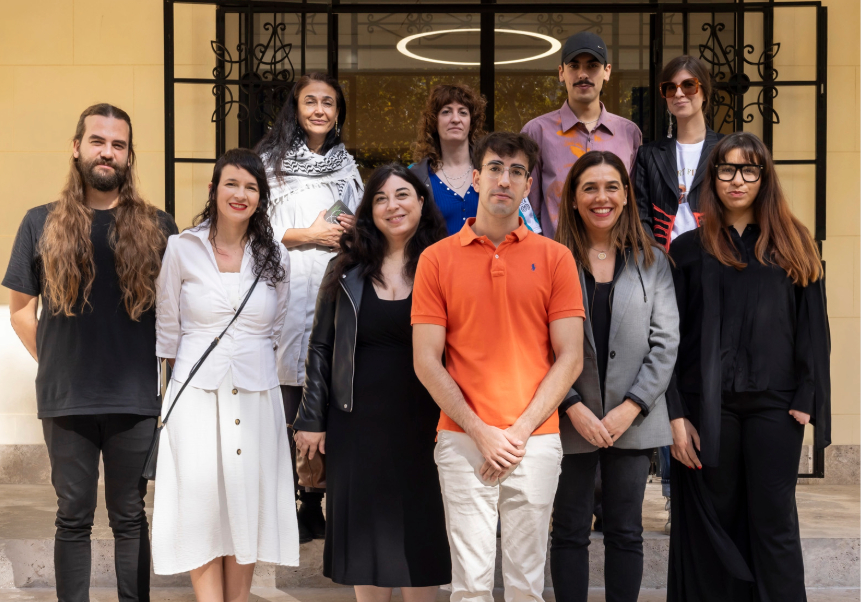The University joins the ‘European Green Capital Status’ with exhibition ‘African activism against climate change’
- Office of the Vice-Principal for Culture and Society
- February 9th, 2024

The Universitat de València, through the programme ‘Culture at the campuses’, inaugurated on Thursday, 8 February the exhibition ‘African activism against climate change’, at the Faculty of Social Sciences (Manuela Ballester Room), at the Tarongers Campus. With this exhibition, the Universitat de València, through the Office of the Vice-Principal for Culture and Society, and the Office of the Vice-Principal for Sustainability, Cooperation and Healthy Life, join European Green Capital Status 2024.
This exhibition kick-starts the activities programme of the Universitat, under this Green Capital Status label, which will consist of a diversity of initiatives throughout the academic year. Next Tuesday, 13, the Universitat inaugurates at the Burjassot Campus an exhibition named ‘What can I do?’, which encourages the university community, and society as a whole, to adopt a more sustainable life style featuring illustrations by Núria Tamarit.
On ‘African activism against climate change’, the struggle of African activists for climate change and human rights is showcased through the East African Crude Oil Pipeline (EACOP) project, a 1,443 kilometres-long oil pipeline between Uganda and Tanzania led by the French oil company Total Energies with the objective of exporting 6.5 billion barrels out of Africa. With an estimated yearly production of 34 million tons of CO₂, this will double the current emissions of Uganda and Tanzania, sparking strong opposition between local activists and environmental organisations, given that it endangers the fight against climate change and goes against the Paris Agreements.
Along a series of images and first-person narrations, the struggle of activists and conservationists is showcased, showing their personal stories and how they conduct work under threat. Different profiles showcasing the many ways African activists fight for their rights against multinational corporations are introduced.
The exhibition is curated by Valencian journalists David Soler Crespo and Pablo Garrigós, and by journalist and political scientist Soraya Aybar Laafou, in the framework of a journalistic research in which the three curators participated, and which was funded by fundations Pascal Decroos Fund and JournalismFun.EU, and published in France (Médiapart), Spain (El País), Belgium (MO* Magazine), and Switzerland (Daslamm). Photographs were taken in September and October 2022, in a variety of locations in Uganda and Tanzania.
According to those in charge of the exhibition, which right now are out of the country due to professional reasons (David Soler, in Nairobi; Pablo Garrigós, in Brussels; and Soraya Aybar, in Morocco), with this project, they aim to “fight against Africanist stereotypes”. Among other objectives, they want to “highlight what happens at those natural parks that attract so many in the West. It is true that they have spectacular flora and fauna, but across them also traverse oil pipelines that violate the human rights of their inhabitants. They sometimes have their homes expropriated. Other times, they have to withstand these conducts being next to their houses”.
The exhibition, which is organised by the Office of the Vice-Principal for Culture and Society, in collaboration with Caixa Popular, is complemented with a series of images that show the impact on the environment, as well as on the habitat of the population of endangered native Rothschild giraffes and chimpanzee communities, just as on mangrove forests and African coral reefs It can be visited until 10 April.
What can I do?, at the Burjassot Campus
The Universitat, through the Office of the Vice-Principal for Sustainability, Cooperation and Healthy Life, the Chair for Cooperation and Sustainable Development, and the Office of the Vice-Principal for Culture and Society, presents on 13 February, at the hall of the Library of the Escola Tècnica Superior d'Enginyeria (ETSE), the exhibition ‘What can I do? How to contribute, as a member of the UV, to a more sustainable life style’, with illustrations by Núria Tamarit.

Through a variety of panels, the university community, and society as a whole, will have the chance to learn how to move, consume, learn, conduct research, care for, and of themselves from different life and consumption styles that veer towards a more sustainable and fair society, in order to fulfil the commitments of the Agenda 2030 and the Sustainable Development Goals. The exhibition can be visited until 20 March.
February, more exhibitions with ‘Culture at the campuses’
More exhibitions are coming in February with the programme ‘Culture at the campuses’, promoted by the Universitat de València, through the Office of the Vice-Principal for Culture and Society. Thursday, 8, at the Tarongers Campus, the exhibition ‘Ortifurama valencià’, a look at the Valencian history and reality through the eyes of the cartoonist Ortifus (Antonio Ortiz Fuster, 1948), was also inaugurated at the hall of the Faculty of Economy. One can also visit at the North Classrooms Building, the exhibition ‘Hidden: Animals in the Anthropocene’, a collection of images that reflect and raise awareness of the problem of animal exploitation. Both exhibitions can be visited until 10 April.
‘Ortifurama valencià’ is an exhibition on Valencian history and reality through the eyes of the exceptional cartoonist Ortifus. The display, opened at the La Nau Cultural Centre in January 2022, has an itinerant nature and is now arriving to the Tarongers Campus. It illustrates the last 40 years (1981-2021) of Valencia through Ortifus’ creations. From institutional advertising, to daily press cartoons, Fallas collaborations, and even directions to access a garage at the urban centre, Ortifus’ drawings —his iconic bog-nosed characters— are present in many spaces and formats, constituting part of the Valencian popular imaginary. The history of València would be lacking without his cartoons, which started being published in 1981 on the pages of the Diari de València, coming next to the Noticias al Día and, lastly, to the journal Levante-EMV, which concentrates most of his production.
On the other hand, the North Classrooms Building is hosting ‘Hidden: Animals in the Anthropocene’, a collection of images that reflect and raise awareness on the problem of animal exploitation and that was exhibited at La Nau this past November. Sponsored by the Friends of Thoreau Programme of the Franklin Institute and the Fundación General de la Universidad de Alcala (FGUA), the exhibition is rooted on the works of the We Animals Media agency, founded in 2019 by award-winning, world-famous Jo-Anne McArthur, main representative of “animal photojournalism”. It encompasses the works of eighteen photography professionals who have documented the conditions of life and death of animals in farms, killing houses, labs, circuses, zoos, and other places where they are used are resources or entertainment.
All exhibitions of the programme ‘Culture at the campuses’ on: http://www.uv.es/cultura
More information:
Categories: Cultura , Exposicions , Altres espais expositius


.jpg)













